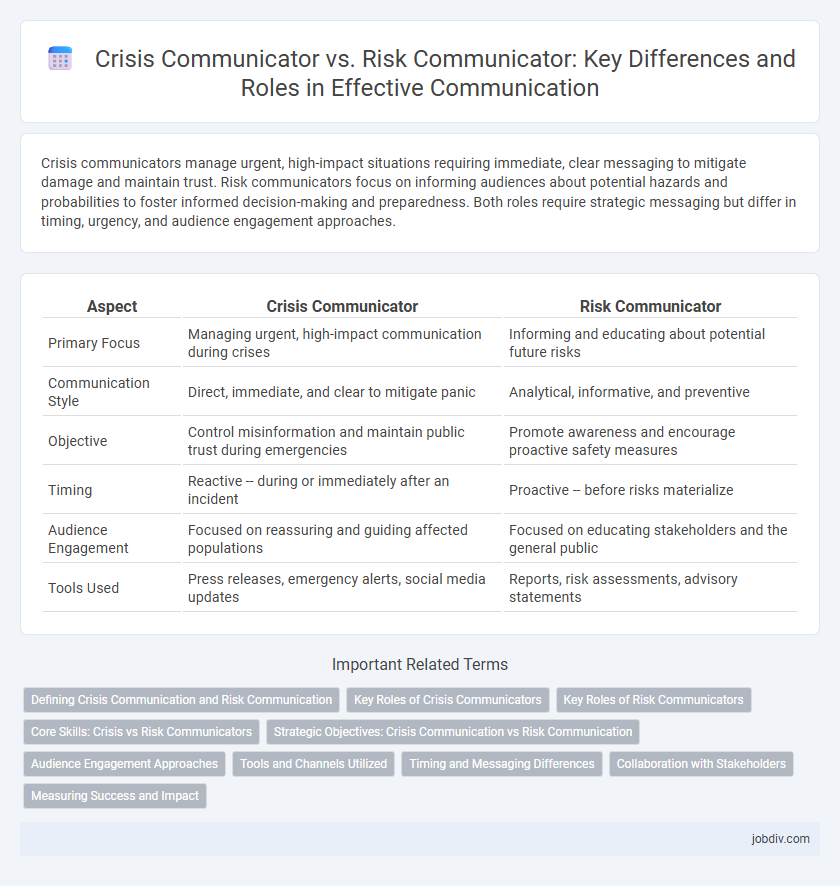Crisis communicators manage urgent, high-impact situations requiring immediate, clear messaging to mitigate damage and maintain trust. Risk communicators focus on informing audiences about potential hazards and probabilities to foster informed decision-making and preparedness. Both roles require strategic messaging but differ in timing, urgency, and audience engagement approaches.
Table of Comparison
| Aspect | Crisis Communicator | Risk Communicator |
|---|---|---|
| Primary Focus | Managing urgent, high-impact communication during crises | Informing and educating about potential future risks |
| Communication Style | Direct, immediate, and clear to mitigate panic | Analytical, informative, and preventive |
| Objective | Control misinformation and maintain public trust during emergencies | Promote awareness and encourage proactive safety measures |
| Timing | Reactive -- during or immediately after an incident | Proactive -- before risks materialize |
| Audience Engagement | Focused on reassuring and guiding affected populations | Focused on educating stakeholders and the general public |
| Tools Used | Press releases, emergency alerts, social media updates | Reports, risk assessments, advisory statements |
Defining Crisis Communication and Risk Communication
Crisis communication involves managing urgent, high-stakes situations that threaten an organization's reputation or operations, requiring immediate response to mitigate damage. Risk communication focuses on informing and educating stakeholders about potential hazards, emphasizing prevention and preparedness to reduce uncertainty. Both disciplines prioritize clear, transparent messaging but differ in timing and objectives--crisis communication addresses imminent issues, while risk communication aims to anticipate and diminish future threats.
Key Roles of Crisis Communicators
Crisis communicators play a crucial role in managing information flow during emergencies by delivering timely, accurate messages that mitigate public panic and maintain trust. They coordinate with multiple stakeholders to ensure consistent messaging across media channels, addressing immediate concerns and clarifying uncertainties. Their key responsibilities include rapid response, transparency, and empathy to effectively navigate high-pressure situations and safeguard organizational reputation.
Key Roles of Risk Communicators
Risk communicators play a crucial role in identifying potential hazards, assessing the likelihood and impact of risks, and conveying clear, accurate information to diverse audiences to prevent or mitigate harm. They develop strategies to build public trust, enhance understanding, and encourage proactive behaviors that reduce vulnerability during uncertain situations. Effective risk communication also involves ongoing monitoring, feedback collection, and adapting messages to evolving conditions and stakeholder concerns.
Core Skills: Crisis vs Risk Communicators
Crisis communicators excel in rapid decision-making, clear messaging under pressure, and managing real-time information flow to mitigate immediate threats. Risk communicators specialize in analyzing data, forecasting potential hazards, and educating stakeholders about long-term safety measures to prevent crises. Both roles require exceptional empathy, audience understanding, and the ability to tailor communication strategies to dynamic and uncertain environments.
Strategic Objectives: Crisis Communication vs Risk Communication
Crisis communicators prioritize rapid response to contain damage, maintain public trust, and ensure clear, accurate information dissemination during emergencies. Risk communicators focus on educating stakeholders about potential hazards, promoting preventive measures, and fostering long-term resilience through ongoing dialogue. Strategic objectives in crisis communication emphasize immediate impact mitigation, whereas risk communication aims to reduce vulnerability through awareness and preparedness.
Audience Engagement Approaches
Crisis communicators prioritize rapid, transparent updates to manage immediate public safety concerns and minimize panic, often using direct messaging channels tailored to affected audiences. Risk communicators focus on educating diverse stakeholders over time, employing interactive tools and feedback loops to build trust and promote informed decision-making about potential hazards. Both roles leverage tailored engagement strategies but differ in immediacy and focus, with crisis communication emphasizing urgency and risk communication fostering ongoing dialogue.
Tools and Channels Utilized
Crisis communicators prioritize rapid-response tools such as social media platforms, emergency alert systems, and press releases to disseminate urgent information quickly. Risk communicators utilize educational channels like community workshops, detailed reports, and newsletters to foster understanding and preparedness over time. Both rely on digital analytics and feedback mechanisms to tailor messaging and ensure effective audience engagement.
Timing and Messaging Differences
Crisis communicators prioritize immediate, clear messaging to manage emergent threats and minimize harm during high-stress events, focusing on real-time updates and actionable information. Risk communicators emphasize proactive, transparent engagement to inform stakeholders about potential hazards, aiming to build trust and promote long-term safety awareness. Timing in crisis communication is urgent and reactive, while risk communication operates on a preventive, strategic timeline to shape perceptions before issues escalate.
Collaboration with Stakeholders
Crisis communicators collaborate closely with stakeholders to provide timely, transparent updates that manage immediate threats and maintain public trust during emergencies. Risk communicators engage stakeholders in ongoing dialogue to educate, assess perceptions, and build preparedness for potential future risks. Both roles require a strategic partnership with stakeholders to enhance resilience and ensure clear, consistent messaging throughout all phases of communication.
Measuring Success and Impact
Crisis communicators measure success by the speed and clarity of information dissemination during emergencies, assessing real-time public response and media coverage to mitigate harm effectively. Risk communicators evaluate impact through long-term behavioral changes, increased awareness, and the adoption of preventive measures by target audiences. Both roles utilize data analytics, feedback loops, and stakeholder engagement metrics to refine communication strategies and enhance overall trust and resilience.
Crisis Communicator vs Risk Communicator Infographic

 jobdiv.com
jobdiv.com